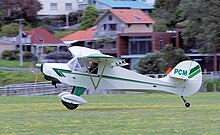Avid Flyer
| Avid Flyer | |
|---|---|

|
|
| Type: | Microlight |
| Design country: | |
| Manufacturer: |
Light aero |
| First flight: |
1983 |
| Number of pieces: |
over 2000 as of 2001 |
The Avid Flyer is a family of single-engine, two-seat , tail - wheeled microlight aircraft . The aspirated high- wing aircraft were developed as a kit by the US company Light Aero in the 1980s . The different variants were sold in large numbers. In 1987, an Avid Flyer was the first microlight to land at the North Pole .
construction and development
The two-seater ultra-light kit was designed by Dean Wilson in 1983. The maiden flight and the presentation at the EAA AirVenture in Oshkosh , Wisconsin took place in the same year. The kits were offered by Light Aero under different names (Bandit, Lite, Magnum Mk.IV) and with many options such as double decker configuration , nose gear landing gear , tail wheel landing gear , skids , floats , total rescue system and a wide range of engines. Production continued until the company went bankrupt in 1998. From 2003, Airdale Flyer built kits of the Avid Flyer again.
The Avid Flyer is a single-engine, two-seat, braced high-wing aircraft. Aluminum tubes serve as wing spars , with each wing additionally supported by two tubular struts. The wing frames are made of sawn plywood and are connected to the aluminum spars with epoxy resin . The wings have flaperons with three hinges each. They can be pushed under the wing, where they stay in a calm, un-swirled airflow at low speeds or at higher angles of attack .
The fuselage , welded from steel tubes, has a rectangular cross-section that tapers towards the rear of the cross tail. The horizontal stabilizer sits just above the fuselage. The elevator and rudder units are moved via wires.
Wilson's motivation to develop the Avid Flyer was to offer an affordable aircraft kit that bridged the gap between conventional small aircraft such as the Piper Cub or models from Taylorcraft or Aeronca and microlight aircraft such as the Quicksilver, which were not safe and mature enough in the early 1980s . The ability to land on short, unpaved runways in rural areas of the United States was also a design requirement. Due to its low weight, good power-to-weight ratio and features such as the flaperons, the Avid Flyer is ideally suited to this terrain and other STOL conditions. Recent developments in the field of small aircraft engines and their reliability made the Avid Flyer a powerful and economical alternative in the LSA area.
Trivia
In 2008, about 2,000 Avid Flyers were built around the world. 346 flyers and magnums were registered in Europe at the time. The most notable use of a Flyer, however, was Hubert de Chevigny's flight in an Avid Lite 532. On April 2, 1987, he took off with a 300 liter additional tank accompanied by Nicholas Hulot in an Aviasud Mistral from Resolute in Canada and flew in three Stages to the North Pole , which he reached on May 7th. This was the first microlight flight to the northernmost point on earth.
variants
- Flyer
- Early variant with angular rudder , folding wings and a 45 HP (33 kW) engine from Cayuna or a Rotax 532 with 65 HP (48 kW).
- Mk IV
- Larger, rounded rudder; Rotax 582 with 64 HP (47 kW) or Rotax 912 engine; Storage space for luggage; introduced in 1992. The Mark IV was later developed into the Airdale Backcountry .
- bandit
- More economical version with a Rotax 503 with 50 HP (37 kW).
- Magnum
- Higher curb weight, powered by a Lycoming O-320 with 160 PS (118 kW) or another engine with an output between 125 PS (92 kW) and 180 PS (132 kW)
Technical data (Mk IV STOL)
| crew | 1 |
| Passengers | 1 |
| length | 17.9 ft (5.5 m ) |
| span | 29.8 ft (9.1 m) |
| height | 6.1 ft (1.9 m) |
| Empty mass | 511 lb (232 kg ) |
| Max. Takeoff mass | 1,151 lb (522 kg) |
| Cruising speed | 92 mph (148 km / h ) |
| Top speed | 105 mph (169 km / h) |
| Max. Rate of climb | 1,000 ft / min (5 m / s ) |
| Service ceiling | 16,000 ft (4,877 m) |
| Range | 340 mi (547 km) |
Web links
Individual evidence
- ↑ a b c Patrick Perrier: Fox-Papa Les avions de construction amateur . Marines Edition, Rennes 2010, ISBN 978-2-35743-048-8 , pp. 48.49 (French).
- ↑ Airdale sport planning and supply. (No longer available online.) Archived from the original ; accessed on April 20, 2011 (English).
- ↑ Dave Partington: European registers handbook 2010 . Air Britain (Historians) Ltd, 2010, ISBN 978-0-85130-425-0 (English).
- ↑ April 20 - May 7, 1987, North Pole. (No longer available online.) Archived from the original ; accessed on July 14, 2011 .
- ^ Robby Martin Bayerl-Berkemeier: World Directory of Leisure Aviation 2011-12 . WDLA UK, Lancaster UK 2011, p. 92 (English).
- ↑ Richard Vandermeullen: 2012 Kit Aircraft Buyer's Guide . In: Kitplanes . tape 28 , no. 12 . Belvoir Publications, December 2011, ISSN 0891-1851 , p. 38 (English).
- ↑ Don Purdy: AeroCrafter - Homebuilt Aircraft Sourcebook . 5th edition. BAI Communications, 1998, ISBN 0-9636409-4-1 , pp. 120 (English).
- ^ Rod Simpson: Airlife's World Aircraft . Airlife Publishing Ltd, Shrewsbury 2001, ISBN 1-84037-115-3 , pp. 64.65 (English).
